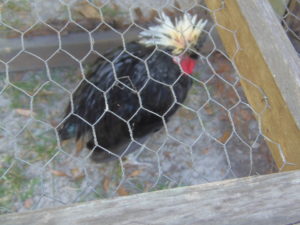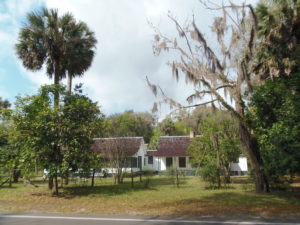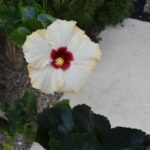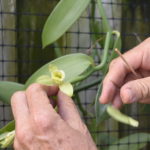
Larry, a Polish Frizzle Head rooster who doesn’t feel well.
Larry has bad karma or good luck depending on whether you are a glass-half-full type of person. One black humid August night in Alachua County Florida when the mosquitoes blanketing the ground were almost as thick as the stars in the clear sky, something bit Larry under his right wing and on his right chicken hip. No feathers were disturbed according to Donna Jenks-Wright, a tour guide at Marjorie Kinnan Rawlings State park.
“They were just two round holes–there may have been neurological damage,” said Jenks-Wright. “He would just fall backward.”
The culprit is a mystery.
“It was probably a snake, ” Jenks-Wight said.
Chickens are a big part of the park’s ambiance. An old farmhouse where Rawlings wrote most of The Yearling (1939) is preserved and maintained using a skill set–cooking on a wood burning stove, for example–that dates back almost a century. Her later book, Cross Creek (1942), is a folksy look at rural life in North Florida (including chicken art work) that has the added dimension of providing a snapshot of southern America’s rural past as the country moved into World War II and took the first steps toward an industrialized economy.
In any case, Larry would have been the proverbial chicken-in-the-pot if he lived in the the 1940s at Cross Creek.
Larry’s good luck started when Jenks-Wright decided to rehabilitate him instead of including him as protein in Sunday dinner. She fed him watermelon and yogurt for a month before moving into some 21st century medical practices.
“I did physical therapy on him, ” said Jenks-Wright, a diminutive middle-aged woman. She has a no-nonsense manner which belies her next sentence.
” I put him on his back and bicycled his little legs.”
Bad karma or good luck, dear reader?
Three months later, Larry is “doing better,” according to Lee Townsend, the park’s weekend ranger.
“He’s still a little shaky on his legs.”

Marjorie Kinnan Rawlings State Park
 Here is an approximation of how Larry would look if he were living at the Corner of Happy and Healthy, a Walgreens drug store advertising catch phrase. Rooster is unnamed–Let’s call him Doug.He resides on the Google free Images site.
Here is an approximation of how Larry would look if he were living at the Corner of Happy and Healthy, a Walgreens drug store advertising catch phrase. Rooster is unnamed–Let’s call him Doug.He resides on the Google free Images site.
Now that Larry is on the road to right, and Doug has been adequately explained if not characterized, let us move on to the topic of frizzle as explained by Donna McGlasson on her blog Gardens & Chickens & Worms Oh My! as republished in a fascinating blog CommunityChickens. I am not playing this for laughs–I reconnected with a long lost friend who was listed as a friend of the blog.
http://www.communitychickens.com
Here is an excerpt gleaned, according to Donna, from the Frizzle Society of Great Britain and Storey’s Guide to Raising Chickens (1995).
Any breed can be frizzled if paired with a frizzle when bred but popular breeds for frizzled feathers are Cochins and Polish.There is also a mixed breed of chickens called Sizzles that are a combination of Silkie and frizzled Cochins. The frizzle gene is bred in both bantam and standard size chickens.
Frizzle apparently is a gene as opposed to a breed. Let’s call it the F gene. It makes chickens a little more vulnerable to bullying from other chickens because the frizzles don’t protect their little chicken heads.
Chicken humor is a great part of the CommunityChickens blog. Some of the party platforms in the recent presidential race as proposed by chickens:
—“Cross the road without having our motives questioned”
–“Not a chicken in every pot”
–“Shelter from falling skies” which I believe is a reference to the nursery tale of Chicken Little.
And the story of Chicken Little starts us on another path which leads us farther for poor sick-but-somewhat-better Larry and so it’s another story for another day.








Fizzle, Frizzle, Thistle down and more- glorious images we want to feel!
Larry, poor sod, perhaps was meant for the pot. Although, one cannot judge by the Chilean Sea Bass and Tenderloin Lover! Hah!